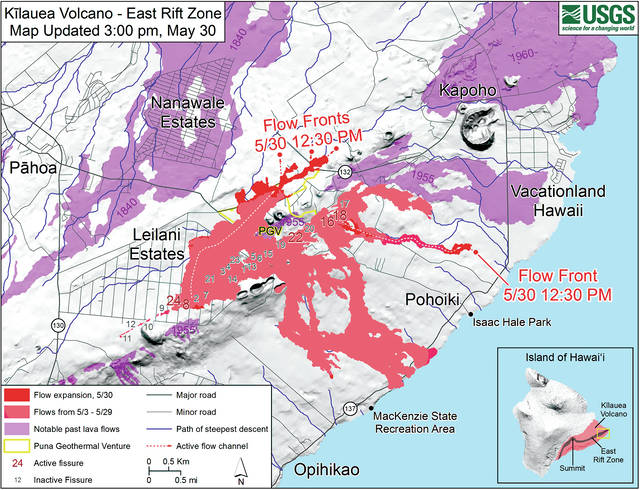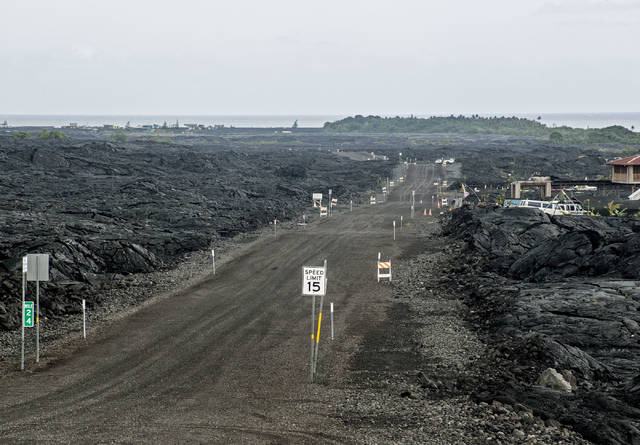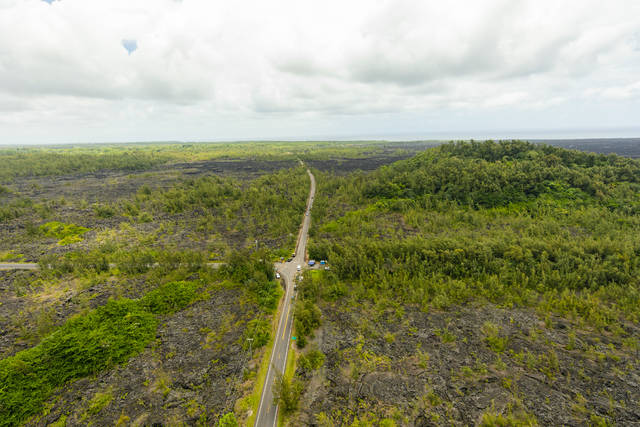Eyes on ‘Four Corners’: Lava imperils intersection used by Kapoho, Vacationland residents

ANDREW RICHARD HARA/Special to Tribune-Herald
This aerial view shows lava crossing Highway 132 on Wednesday in lower Puna.


HOLLYN JOHNSON/Tribune-Herald
Chain of Craters Road in Kalapana.

ANDREW RICHARD HARA/Special to Tribune-Herald
An aerial view of the junction of Highway 132, Highway 137 and Government Beach Road, also known as “Four Corners.”
Bulldozers began digging their way through lava rock on Chain of Craters Road on Wednesday as molten rock continued to threaten the “Four Corners” area in Kapoho.
Bulldozers began digging their way through lava rock on Chain of Craters Road on Wednesday as molten rock continued to threaten the “Four Corners” area in Kapoho.
Chain of Craters Road, which goes through Hawaii Volcanoes National Park and connects with Highway 130 in Kalapana, would be used as an evacuation route should the lower Puna eruption sever the highway.
ADVERTISING
The work could take four days or more than a week, according to varying estimates. A 0.7-mile section is covered by lava from the “61g” flow in 2016 and 2017.
In 2014, a 7-mile section was recut to allow for evacuations when lava threatened Pahoa. According to the park, it has been blocked by lava for 41 of its 53-year existence.
Meanwhile, Civil Defense officials and geologists continued to track a lava flow that was heading toward the junction of Highway 132, Highway 137 and Government Beach Road, known as Four Corners. Loss of that intersection would isolate residents in Kapoho and Vacationland, who were urged to evacuate at about 1 a.m. Wednesday.
That flow was being fed by fissure No. 8 in Leilani Estates, which was fountaining lava about 200 feet into the air.
Jim Kauahikaua, a Hawaiian Volcano Observatory geophysicist, said it was “too early to tell” when lava could reach that point.
By 6 p.m. Wednesday, it was 2.5 miles from Four Corners.
While the eruption remained vigorous, he said the flow rate had dropped substantially from 600 yards an hour to between 45 and 85 yards an hour. The flow was split between three different lobes, Kauahikaua said.
A separate flow was about a half-mile from Highway 137 in the vicinity of Ahalanui Park, also known was the “hot pond.”
Talmadge Magno, Hawaii County Civil Defense administrator, said Kapoho residents were being allowed back in to retrieve items, but like in Leilani Estates, they need to be out by 6 p.m. Currently, the only road in and out of that area is Government Beach Road.
He estimated the amount of people displaced so far to be up to 2,500 and said evacuation shelters were housing 353 people.
“A lot of folks showed up early in the morning in their vehicles and just stayed in their vehicles in the parking lot,” Magno said.
He said 75 homes have been destroyed by the eruption since it started May 3 in Leilani on Kilauea’s East Rift Zone. It’s since laid waste to much of the lower half of the subdivision and Lanipuna Gardens.
Explosive eruptions at the summit continue, with one sending ash 12,000 feet above sea level Wednesday morning.
Wendy Stovall, a U.S. Geological Survey volcanologist, said the eruption is now only producing “Pu‘u ‘O‘o magma,” which is hotter than what was seen in the first few weeks. At the start, geologists say magma stored from earlier eruptions was making it to the surface.
Lava has isolated the Puna Geothermal Venture power plant and destroyed some buildings. While lava had encroached onto well pads, Magno said the plant was stable.
The 38-megawatt power plant has been offline since the eruption began. Rhea Lee-Moku, Hawaii Electric Light Co. spokeswoman, said other power facilities are picking up the slack, though the average residential customer will see an increase of $2.60 in their June bills because of the loss of PGV.
The eruption forced the relocation of Kua O Ka La Public Charter School, located near Ahalanui Park, to Hilo.
Susie Osborne, who is head of the school and lost her own home to lava in Leilani, said its 232 students had their last day of the school year Wednesday. She said the school, which faces the loss of its campus because of the eruption, plans to continue in Hilo next year. Since relocating, it has been using the New Hope Church and Boys and Girls Club facilities.
Osborne said about half the students were evacuated from their homes, adding the disaster has brought the students and faculty closer together. She said the school continues to accept new students and donations.
Email Tom Callis at tcallis@hawaiitribune-herald.com.


